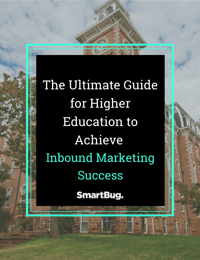
How to Optimize Post-Pandemic Higher Education Enrollment Rates
July 23, 2021
Do you remember applying for university ten years ago? Picture it: You pored over the university brochures a guidance counselor or college fair representative handed you, heard a radio advertisement on your way to school, parsed through bare-bones websites, and circled degree programs in course catalogs. Finally, you narrowed it down to a handful of choices. After filling out your applications (and nursing the subsequent hand cramps), you sat ... and waited.
Let’s skip forward to the present-day higher education enrollment experience. Students seeking a university education are no longer reading brochures, nor are they waiting for referrals.
Today’s prospective students are in the driver’s seat and have become top-notch researchers before they’ve even enrolled. Students are going online to find their perfect fit. Beyond finding a college that offers their degree program, they’re looking for a university aligned to their values, and all of that information is a few search queries away.
Recruitment via traditional marketing strategies are no longer sufficient to gain the attention and interest of prospective students. It’s time to meet learners where they’re interacting, which means that universities need to take a different approach to recruiting efforts. To really capture the interest of and engage prospective students, higher education marketers that embrace inbound marketing strategies will stand out from competing schools, quickly grow leads, and effectively meet students where they are looking.
Let’s explore ways inbound marketing tactics can create a journey that attracts, engages, and delights learners applying to colleges and universities in a post-pandemic world.
Embrace the shifting landscape of a post-pandemic education.
The pandemic has reshaped the education industry by modifying the way we approach learning. Although online learning isn’t a new practice by any means, COVID-19 accelerated the shift to a virtual learning experience, which included new ways to provide resources for remote students.
As any college student or graduate can tell you, earning a degree isn’t simply about sitting in a classroom and regurgitating information for a grade. Extracurricular activities, clubs, and opportunities to meet people from all walks of life are all part of the college experience that prepare students for coworker interactions and practicing work-life balance. The pandemic highlighted the need for universities to create a full college experience from a remote location for students who were growing ever-more skeptical of the value of a higher education degree.
With that change in motion, it quickly became evident that O.G. marketing tactics were not a sustainable way to gain student interest. Radio advertisements, doorstop-thick course catalogs, and billboards are no longer part of an effective recruiting strategy. Universities should instead be getting to the heart of prospective students by using inbound marketing strategies.
What is the inbound university approach?
Inbound marketing methodology places a human-centered focus on the buyer’s journey. A university leveraging inbound marketing gets down to the heart of prospective and current students by building meaningful and lasting relationships via trust and value-based nurturing. Using an inbound strategy is more effective than de-personalized outbound tactics because part of inbound means meeting people where they are.
The “inbound university” uses digital messages, an improved online experience, and fosters a higher education community of learners with students located anywhere in the world. Using this approach, there are many ways to gain student buy-in.
Try these effective strategies for optimizing higher education enrollment.
How can we apply the inbound methodology to improve enrollment at higher education institutions? A good campaign is backed by insight.
Universities should start by researching their strengths and weaknesses as a campus. The best way to research would be starting from within, meaning gathering information from current students and staff. The answers provided will serve as top reasons students should choose their university.
1. Find the Audience
With a list of strengths in hand, the university should create a value proposition. This is essentially an elevator pitch to prospective students that specifically states why that university stands out. The elevator pitch is the bottom line, and every tactic should be created in a way that supports the value proposition. So now that there’s a “why,” universities should seek out the “who” and the “where”—i.e., audiences the pitch will resonate with.
I like to think of the inbound methodology in action as telling a story. A great story pulls an audience in with an interesting plot and keeps the audience engaged with events and ideas that support the story as a whole. So how do universities tell stories? First, they should find an audience willing to listen. That means presenting a value proposition on their prospect’s storytelling platforms—social media, digital advertisements, college fairs, and so forth.
2. Create Interest with Targeted Content
Once a university has an audience, the real fun begins. Keeping an audience engaged is no easy task, which is why universities need to be strategic in what they say and how they say it. Universities can create a compelling story by learning about their audience and answering any questions they have about pursuing a higher education degree. Once students are listening to the story, the university must build trust with content that keeps them listening.
Prospects listen to what they want to hear, which means that universities should be listening to their audience and creating content accordingly. Think about a university’s enrollment counselors: As ambassadors for the university, they are the first person prospective students meet and field any initial questions students may have. It’s a safe bet that counselors hear the same questions more than once, and that is where universities can tell a story prospects want to hear by creating content that answers their questions.
Going beyond simple brochures, universities can gain traction on existing interest with comparison infographics, checklists, or Q&A fact sheets. These resonate with prospects because they feel they’re being heard with resources that focus on them and their needs.
That’s not the end of the story though, not by a long shot. Once prospective students are listening, universities need to keep them engaged throughout their search as well as their time as an enrolled student.
Higher education institutions can keep students engaged by crafting a great university experience. Colleges can create a user-friendly website and provide career counseling plus post-degree support. Creating premium content, such as a degree program roadmap or time management checklist, shows students that the university supports and serves them. Now that is a story worth listening to.
But wait, there’s more!
3. Evaluate Results and Improve the Story
Remember the first step of gathering data? Once universities have told their story, they go right back to measuring the strengths of their campus. Tracking the success of marketing efforts helps universities identify what is (and isn’t) working. To keep track of campaign markers and engagement metrics, universities should adopt a customer relationship management (CRM) platform that keeps crucial records that analyze efforts. These insights also shed light on the audience that isn’t listening to the university’s story (i.e., the cold leads).
While the thought of “cold leads” might cause the “you win some, you lose some” mentality, a good inbound campaign doesn’t count this audience segment out. The beauty of the inbound university is that they see cold leads as a great opportunity to create new stories. By building targeted nurtures that focus on prospective students’ pain points, interests, lifecycle stages, or roadblocks, universities can help remind leads why they were initially interested in the first place.
Is your university ready to embrace inbound?
Although there aren’t many silver linings born from the pandemic, one thing is certain: Change is here. Too many universities are still sticking to traditional marketing tactics to reach prospective students, and their efforts are falling short.
Inbound marketing has the potential to completely revolutionize the way universities and potential students interact with each other. Prospective students are already online, and that’s where the opportunity to optimize higher ed enrollment rates lies.
By identifying your university’s value proposition, finding your audience, and creating relevant content, you’ll garner loyal prospects. Using the data insights gathered in your university’s CRM, you can meet your students where they are and kick-start both your enrollment and student experience. For more information about using inbound marketing to optimize enrollment at your institution, get a copy of our e-book, The Ultimate Marketing Guide for Higher Education to Achieve Inbound Success.

About the author
Brittany Glasscock was formerly a Marketing Specialist at SmartBug based in The Woodlands, Texas. She started her career in the K-12 industry and transitioned into content marketing for a B2B SaaS company. When she's not rocking awesome inbound strategies for clients, she runs (poorly), travels as much as possible, and tries not to burn her kitchen down while cooking. Read more articles by Brittany Glasscock.









